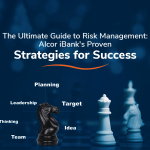Introduction
In the ever-evolving landscape of business, the heartbeat of sustained growth lies in innovation. New product development (NPD) stands as a beacon, illuminating the path to future success. However, the journey is not without its challenges. To mitigate potential pitfalls and ensure a smoother voyage, an integral component of NPD is risk assessment. This blog serves as a compass for those navigating the waters of innovation, shedding light on the importance of risk assessment in the ever-evolving landscape of bringing new products to market.
What is Risk Assessment?
Risk assessment is a systematic process that involves identifying, analyzing, and evaluating potential risks or uncertainties within a project, process, or organization. The first step is identifying potential risks from various sources, such as internal processes, external factors, and market dynamics. Subsequently, these risks are analyzed to understand their nature and potential impact, followed by an evaluation of their significance based on likelihood and consequences. The process then moves to risk mitigation or management, where strategies are developed to reduce the impact or likelihood of identified risks. Continuous monitoring and periodic reviews are crucial to adapt to changing circumstances. In essence, risk assessment empowers organizations to proactively manage uncertainties, make informed decisions, and enhance their ability to achieve objectives while minimizing adverse effects.
What is New Product Development?
New Product Development (NPD) is the process by which a company conceptualizes, designs, creates, and brings a new product or service to the market. This multifaceted process involves various stages, from the initial idea generation to the final introduction of the product to consumers. The primary goal of NPD is to capitalize on market opportunities, stay competitive, and meet the evolving needs and desires of consumers. Successful NPD requires a combination of innovation, market insight, effective project management, and adaptability to changes throughout the development process. It is a crucial aspect of a company’s strategy for growth and sustainability in today’s competitive business environment.
Innovation in Product Development
At its core, innovation is the lifeblood of progress. It propels companies forward, opening doors to new opportunities and markets. However, the path to innovation is not a straight line; it’s a dynamic process characterized by twists, turns, and unforeseen hurdles. Within the realm of new product development, where ideas materialize into tangible offerings, the synergy between innovation and risk becomes palpable.
Navigating New Product Challenges
The intricacies of NPD demand a strategic approach. It’s not just about conceptualizing groundbreaking ideas but also about foreseeing and effectively addressing potential challenges. This is where risk assessment steps into the spotlight, offering a structured methodology to identify, analyze, and mitigate risks that may arise throughout the product development lifecycle.
Strategic Risk Assessment
Risk assessment in the context of new product development is akin to charting a course through uncharted waters. It involves a meticulous evaluation of the internal and external factors that could impact the success of a new product. By employing strategic tools such as SWOT analysis, failure mode and effects analysis (FMEA), and scenario planning, businesses can gain a comprehensive understanding of the risks at play.
As we delve into this exploration, we will unravel the significance of cross-functional collaboration, continuous monitoring, and iterative assessment in fostering innovation while minimizing potential setbacks. Join us on this journey through the intricacies of innovation, new product development, and the strategic art of risk assessment. Together, we will unveil the keys to successful product ventures in an ever-evolving market.
The Importance of Risk Assessment in New Product Development
New Product Development (NPD) is a dynamic process that propels businesses into the future by introducing innovative offerings to meet evolving consumer needs. While innovation is the cornerstone of success in this landscape, the journey is fraught with uncertainties. This is where the significance of risk assessment in NPD becomes paramount.
Identifying and Understanding Risks
- Market Uncertainties
Navigating uncharted markets can be akin to sailing through turbulent waters. Risk assessment allows businesses to identify and understand market uncertainties, enabling them to tailor their strategies to mitigate potential challenges.
- Technical Challenges
The development of new products often involves cutting-edge technologies and methodologies. Risk assessment helps in anticipating and addressing technical challenges, ensuring a smoother transition from concept to market.
Resource Allocation and Cost Management
- Optimal Resource Allocation
In the realm of NPD, resources are finite, and their allocation must be strategic. Risk assessment provides insights into where resources are most needed, optimizing the allocation process for maximum efficiency.
- Cost Management
Financial prudence is a crucial aspect of a successful NPD. Risk assessment aids in anticipating potential cost overruns, enabling businesses to establish realistic budgets and contingencies.
Time-to-Market Optimization
- Proactive Time Management
Time-to-market is often a critical factor in the success of a new product. Risk assessment allows teams to proactively manage potential delays by identifying factors that could hinder the development timeline.
- Agile Strategies
Understanding the risks associated with time-to-market pressures enables businesses to develop agile strategies. This adaptability is key in responding swiftly to market demands and gaining a competitive edge.
Mitigating High-Impact Risks
- Prioritizing Risks
Not all risks are created equal. Some carry higher consequences than others. Risk assessment helps in prioritizing risks based on their potential impact, allowing businesses to focus their attention and resources on addressing the most critical issues.
- Contingency Planning
Effective risk assessment goes hand in hand with contingency planning. By identifying high-impact risks, businesses can develop contingency plans to mitigate the effects and ensure a more robust response if and when a risk materializes.
Learning from Past Experiences
- Continuous Improvement
Past projects serve as valuable learning experiences. Through risk assessment, businesses can analyze what worked well in previous NPD endeavors and what didn’t. This knowledge contributes to continuous improvement in future projects.
- Informed Decision-Making
Informed by past experiences and a thorough understanding of potential risks, decision-makers are better equipped to make sound judgments. This proactive approach minimizes the likelihood of repeating mistakes and maximizes the chances of success.
Collaborative Approach and Cross-Functional Insights
- Cross-Functional Collaboration
NPD is a multidisciplinary effort. Risk assessment encourages cross-functional collaboration, ensuring that insights from various departments are considered. This collaborative approach fosters a holistic understanding of potential risks.
- Holistic Decision-Making
Cross-functional collaboration not only brings diverse perspectives to the table but also facilitates holistic decision-making. When individuals from different departments contribute their insights to risk assessment, the resulting strategies are more comprehensive.
In conclusion, the importance of risk assessment in new product development cannot be overstated. It is the compass that guides businesses through uncharted territories, helping them anticipate challenges, allocate resources judiciously, and navigate the intricate dance between innovation and uncertainty. Successful NPD is not just about developing groundbreaking products but also about understanding and managing the risks inherent in the journey. Embracing a proactive approach to risk assessment ensures that businesses are not merely passengers on this journey but adept navigators, steering toward success in an ever-evolving market.
Best Practices in Risk Mitigation
Effective risk mitigation in new product development (NPD) is crucial for ensuring a smooth journey from ideation to market launch. By adopting best practices in risk mitigation, businesses can navigate uncertainties with agility and resilience.
- Cross-Functional Collaboration
- Embrace cross-functional collaboration as a foundational best practice in risk mitigation.
- Involving team members from various departments ensures a diverse range of perspectives during risk assessment.
- This collaborative approach allows for a holistic understanding of potential challenges and fosters innovative solutions.
- Continuous Monitoring and Iterative Assessment
- Risk mitigation is not a one-time effort but an ongoing process.
- Implement continuous monitoring mechanisms to track identified risks and assess their evolution throughout the NPD lifecycle.
- Iterative assessments enable teams to adapt strategies in real-time, responding effectively to changing circumstances.
- Contingency Planning
- Developing robust contingency plans is a cornerstone of effective risk mitigation.
- Identify high-impact risks through comprehensive risk assessment and formulate contingency plans that outline predefined responses.
- These plans serve as a roadmap, ensuring that teams are prepared to address challenges swiftly and efficiently.
- Learning from Past Experiences
- Harness the power of learning from past experiences to refine risk mitigation strategies.
- Analyze the outcomes of previous NPD projects, identifying successful risk mitigation practices and areas for improvement.
- This knowledge contributes to a culture of continuous improvement, enhancing the effectiveness of risk mitigation efforts.
- Scenario Planning
- Integrate scenario planning into risk mitigation strategies.
- Envisioning potential future scenarios allows teams to develop proactive responses to a variety of situations.
- By anticipating different outcomes, businesses can make informed decisions and implement flexible strategies to address unforeseen challenges.
- Expert Opinions and Delphi Method
- Seeking expert opinions from individuals with relevant industry experience adds valuable insights to risk mitigation efforts.
- The Delphi Method, a structured communication technique involving iterative surveys among a panel of experts, can help in achieving consensus on potential risks and effective mitigation strategies.
- Time-to-Market Optimization
- Recognize the importance of time-to-market optimization in risk mitigation.
- Time constraints can amplify risks, making proactive time management essential.
- Agile strategies that allow for rapid adjustments and responses to potential delays contribute to effective risk mitigation.
- Resource Allocation
- Optimize resource allocation as a strategic risk mitigation practice.
- A thorough understanding of potential risks helps in directing resources to critical areas.
- By allocating resources judiciously, businesses enhance their ability to address challenges and ensure a more efficient NPD process.
In conclusion, successful risk mitigation in new product development involves a combination of strategic practices that promote collaboration, flexibility, and continuous improvement. By embracing these best practices, businesses can not only navigate uncertainties but also position themselves for sustained success in the ever-evolving landscape of product innovation.
Conclusion
In conclusion, as businesses embark on the exhilarating journey of new product development (NPD), the strategic significance of risk assessment cannot be overstated. Innovation, the lifeblood of progress, must be accompanied by a vigilant understanding of potential challenges. Through meticulous risk assessment, companies can identify, analyze, and mitigate uncertainties, paving the way for a smoother and more resilient NPD process.
By adopting best practices such as cross-functional collaboration, continuous monitoring, and contingency planning, organizations can navigate the intricate dance between innovation and risk with agility. Learning from past experiences and leveraging expert opinions further fortifies risk mitigation efforts, contributing to a culture of continuous improvement.
For a comprehensive risk assessment tailored to the unique needs of your NPD endeavors, consider reaching out to Alcor iBank. Our expertise in strategic risk management can provide valuable insights and guidance, ensuring that your innovation journey is not only groundbreaking but also well-prepared for the challenges that may arise. In the dynamic landscape of product development, where innovation meets uncertainty, proactive risk assessment is the compass that guides businesses toward sustained success and growth.





